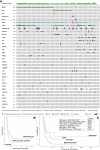Dissecting Anaplastic Thyroid Carcinoma: A Comprehensive Clinical, Histologic, Immunophenotypic, and Molecular Study of 360 Cases
- PMID: 32284020
- PMCID: PMC7583343
- DOI: 10.1089/thy.2020.0086
Dissecting Anaplastic Thyroid Carcinoma: A Comprehensive Clinical, Histologic, Immunophenotypic, and Molecular Study of 360 Cases
Abstract
Background: Anaplastic thyroid carcinoma (ATC) is nearly always fatal. Large studies on ATC are exceedingly rare. We aimed to study the clinical, genotypic, and histologic characteristics of ATC in the largest retrospective cohort of ATC to date. Methods: Three hundred sixty patients with ATC from two tertiary centers were studied. Molecular testing was performed in 126 cases including 107 using next-generation sequencing. Results: The median patients' age was 68 years. Differentiated thyroid carcinoma (DTC) was present in 208 cases (58%), the most common being papillary carcinoma (n = 150). The 1-, 2-, 3-, and 5-year overall survival (OS) was 36%, 17%, 13%, and 11%, respectively. On univariate analysis, age, resectability, chemotherapy, radiotherapy, margin status, encapsulation, gross residual disease, gross extrathyroidal extension, percentage, and size of ATC in the primary tumor predicted OS (p < 0.05). Age, resectability, chemotherapy, and gross residual disease were independent prognostic factors in the entire cohort, while gross residual disease was the only independent predictor of OS in patients who had resection of their tumor. BRAF, RAS, TERT promoter, TP53, PIK3CA, E1F1AX, and PTEN mutations were detected in 45%, 24%, 75%, 63%, 18%, 14%, and 14% of ATC, respectively. Concomitant BRAF/RAS and TERT mutations were associated with worse outcome than mutation in only one of the genes. BRAF-mutated and RAS-mutated ATCs had similar frequency of nodal and distant metastasis. Twelve cases were pure squamous cell carcinoma, 60% of which carried BRAFV600E mutation and showed a similar OS to other ATCs. Conclusions: (i) Gross residual disease remains the most crucial indicator of outcome in ATC. (ii) Encapsulation, margin status, percentage, and size of ATC in the primary were prognostically relevant. (iii) Pure thyroid squamous cell carcinoma may be considered as ATC given a BRAFV600E genotype and similar outcome. (iv) In contrast to DTC, BRAF-mutated and RAS-mutated ATCs have similar metastatic spread. (v) Concomitant mutations of BRAF or RAS with TERT confer a worse prognosis.
Keywords: BRAF; RAS; TERT; anaplastic thyroid carcinoma; prognosis; undifferentiated thyroid carcinoma.
Conflict of interest statement
No competing financial interests exist.
Figures



References
-
- Landa I, Ibrahimpasic T, Boucai L, Sinha R, Knauf JA, Shah RH, Dogan S, Ricarte-Filho JC, Krishnamoorthy GP, Xu B, Schultz N, Berger MF, Sander C, Taylor BS, Ghossein R, Ganly I, Fagin JA. 2016. Genomic and transcriptomic hallmarks of poorly differentiated and anaplastic thyroid cancers. J Clin Invest 126:1052–1066 - PMC - PubMed
-
- Xu B, Ghossein R. 2016. Genomic landscape of poorly differentiated and anaplastic thyroid carcinoma. Endocr Pathol 27:205–212 - PubMed
Publication types
MeSH terms
Substances
Grants and funding
LinkOut - more resources
Full Text Sources
Medical
Research Materials
Miscellaneous

